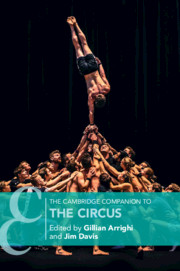Book contents
- The Cambridge Companion to the Circus
- Cambridge Companions to Theatre and Performance
- The Cambridge Companion to the Circus
- Copyright page
- Contents
- Figures
- Contributors
- Acknowledgements
- Timeline
- Introduction
- Part I Transnational Geographies of the Modern Circus
- Part II Circus Acts and Aesthetics
- Chapter 7 The Equestrian Circus
- Chapter 8 Animals, Circus, and War Re-enactment
- Chapter 9 Circus Clowns
- Chapter 10 Aerial Performance
- Part III Circus
- Part IV Circus Studies Scholarship
- Bibliography
- Index
- References
Chapter 10 - Aerial Performance
Aerial Aesthetics
from Part II - Circus Acts and Aesthetics
Published online by Cambridge University Press: 22 June 2021
- The Cambridge Companion to the Circus
- Cambridge Companions to Theatre and Performance
- The Cambridge Companion to the Circus
- Copyright page
- Contents
- Figures
- Contributors
- Acknowledgements
- Timeline
- Introduction
- Part I Transnational Geographies of the Modern Circus
- Part II Circus Acts and Aesthetics
- Chapter 7 The Equestrian Circus
- Chapter 8 Animals, Circus, and War Re-enactment
- Chapter 9 Circus Clowns
- Chapter 10 Aerial Performance
- Part III Circus
- Part IV Circus Studies Scholarship
- Bibliography
- Index
- References
Summary
The origins of aerial performance are difficult to identify with any certainty, but ever since Jules Léotard popularised trapeze in the mid-nineteenth century, aerial arts have captured the public imagination. The role that aerial action has played, and continues to play, within performances is to provide spectacle and sensation. Although aerial action appears to demonstrate performers taking real risks, there is a distance between what the performer experiences and the audience perceives. Examining both key historical figures and contemporary practice, this chapter proposes four aesthetics for aerial performance: weightlessness, risk, gender, and physical appearance.
Keywords
- Type
- Chapter
- Information
- The Cambridge Companion to the Circus , pp. 155 - 168Publisher: Cambridge University PressPrint publication year: 2021
References
Further Reading
- 1
- Cited by

